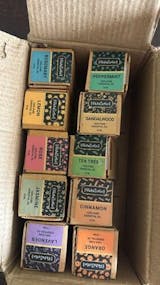Candle Making Supplies - All Candle Supplies Under One Roof
Candle Making Supplies are a must if you want to start a candle-making business. These supplies include wax, wicks, candle jars, wick holders, and molds. VedaOils is offering all the candle-making supplies on a single platform to facilitate a hassle-free process for buying the essentials required for making candles.
Our Candle Making Material supplies also include the DIY candle making kit that are ideal for beginners and makers of DIY homemade candles. All the candle-making essentials along with the guide and instructions for making candles are available in these kits.
Our candle-making supplies list includes a wide variety of candle jars, candle wax, candle molds, wicks, sustainers so that you can purchase the candle-making materials as per your requirements. Our candle-making essentials also include fragrance oil and other natural ingredients like floral petals. These ingredients are necessary to make luxurious and scented candles for gifting our business purposes. Choose us if you want to buy all the candle raw materials from a single place!
Wide Range of Candle Making Material At Bulk Price
- Candle Waxes : We are offering high-quality and organic candle making waxes that are eco-friendly and convenient to use. These waxes help you to make candles that burn cleanly and do not release any toxins in the air.
- Check out beeswax pellets, flakes, slabs, and semi-refined waxes for candles.
- Candle Molds : Candle molds of different materials, shapes, and sizes are available on our portal. Get these molds at cost-effective prices and set candles of various sizes and shapes without any hassles to grow your business
- Candle Wicks : Pick long-lasting and high-quality candle wicks material that is available in different materials and sizes on our portal. Pick the wicks that float in the liquid wax or durable cotton wicks as per your requirements.
- Candle Wick Sustainer : VedaOils is offering high-quality wooden and metallic candle wick sustainers that keep the candle wicks in place. Our sturdy and durable wick sustainers are reusable and easy to use.
- Candle Jars : Purchase premium-quality metallic, ceramic, and glass jars from our site. We are offering clear, frosted, and amber-colored glass jars as well. These multipurpose candle jars can be utilized for storing food items too!
- Fragrance Oils : Check out more than 75+ fragrance oil for candle Making, which offers a pleasant and uplifting aroma. Give a pleasant aroma to your ambiance and make your guests feel special by lighting up your rooms with perfumed candles made up with fragrance oils.
- Candle Making Kit : Find all the candle-making essentials for beginners in our cost-effective candle-making kit. We are offering kits with different combinations of wax and fragrance oils so that you can make different types of candles.
Why Choose Vedaoils for Candle Making Material
VedaOils is offering a wide range of candle-making raw materials at Wholesale prices. The following features make our candle making supplies perfect for both amateur and professional candle makers:
- Wholesale Price Advantage : We are offering candle-making raw materials in bulk and at wholesale prices. Therefore, it becomes a profitable proposition as you can make huge quantities of candles without investing much.
- Worldwide Delivery : Our logistic partners enable us to supply our candle-making essentials throughout India and abroad as well. We are known for keeping our promises when it comes to the delivery date.
- Easy Payment & Heavy Discounts : Order materials needed to make candles at big discounts and get benefit from a quick and convenient payment process. On the special occasion of Christmas, we are offering a heavy discount on all our candle-making supplies!
- Quality & Lab-tested Products : We follow the highest standards of purity, quality, and durability while manufacturing & packing candle supplies. Our lab-tested products work perfectly irrespective of the climate and weather conditions and provide the best results to our customers.
Buy Candle Making Raw Material Online at Wholesale Prices
We are the leading high-quality candle-making raw material manufacturers, suppliers, and distributors in India. Shop all supplies needed to start a candle-making business at wholesale price. We also offer other materials needed to make scented candles at bulk prices and heavy discounts for your small and big business.
VedaOils is dedicated to customer support, and we have employed an expert panel and staff for rendering exceptional support services to address any queries, complaints against candle-making material.












 Sign in
Sign in Register now
Register now My Reward Points
My Reward Points
















